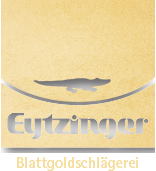Bronze and bronzing – all that glitters is not gold
Bronze is used when a surface is to be given a metallic sheen and, for costs reasons, gilding with genuine gold leaf or imitation gold leaf is not an option. However, this alloy made from copper and zinc is not weather-resistant. Even though careful processing can delay oxidation, the process cannot be stopped altogether.
In order to process bronze, you use an oily or aqueous binding agent to create a so-called bronze tincture. This tincture must be acid-free because otherwise, the bronze instantly loses colour and sheen as a result of oxidation. It should have as low a viscosity as possible, since a bronze tincture that is too thick impairs the glossiness of the bronze.
There are various options for the self-manufacture of oily or aqueous bronze tinctures, which are tailored specifically to the planned bronzing work:
- Transparent, acid-free varnishes which can be thinned with white spirit
- Gum arabic dissolved in water
- Gelatine solution with a few drops of spirit with a small addition of sugar water
Bronzing with a varnish tincture directly applied onto a mixtionised surface gives a sealed, shiny and metallic surface. However, this must be immediately sealed with an acid-free varnish.
Tip: Removing old coatings of bronze is very labour-intensive and not gentle on the substrate. Before processing bronze, the intended use must be carefully considered. Bear in mind that old gildings can be quickly “restored” with a coat of bronze, however the substrate will be irreparably damaged for future use.


